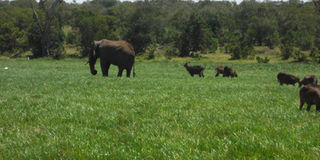Lounging with man’s closest relatives

PHOTO | RUPI MANGAT The swamp at Ol Pejeta.
What you need to know:
- Sweetwaters is a luxury tented camp at the centre of the 110,000-acre Ol Pejeta Conservancy in Laikipia
- It is 217 kilometres from Nairobi and 17 kilometres from Nanyuki
Everyone is out for a game drive and I have an afternoon to myself, watching whatever ambles by. A rhino strolls in the distance and sacred ibis spread their white wings and land in the waterhole. A herd of copper-coloured impala – a handsome male and what could easily be a hundred females gradually make their way to the water. The black rhino moves away, nibbling on the shrubs.
We are at Sweetwaters Tented Camp in Ol Pejeta Conservancy, which boasts the largest black rhino sanctuary in East Africa. There are also southern white rhinos here and the rarest – four northern white rhino that arrived in 2009. At night the red moon brings out sharp silhouettes of two lionesses on the prowl.
CHIMPS WITH STRANGE TRAITS
There are also herds of elephants in the bushes feeding in the moonlight, waterbuck by pools of water, jackals and nocturnal birds like nightjars and owls. However, the stars of the conservancy are the chimpanzees and I hope to see my adopted chimps, Mwanzo and Ajabu – a mother-daughter pair. Joseph Maiyo, who has been the supervisor at the chimp sanctuary since 1993, escorts us to the chimps – our closest living relatives.
Max is a big chimp but he has no appetite for any of the fruits the keeper is handing him through the fence. He doesn’t catch the oranges, bananas or avocadoes; everything goes flying out through the fence.
“He’s not hungry,” confirms Maiyo. “He had quite a bit to eat earlier and he doesn’t not like oranges.” Poko struts in and ignores everyone. He is the star chimp – one of the first to arrive at the sanctuary and is easily recognisable because of his straight gait. He spent nine years of his life in a tiny cage where he could only stand or crouch. The cage was hung over a garage to attract customers – hence his habit of walking straight. Next, Oscar the alpha male makes his entrance. He is really big and strong. He’s had a fight with Ali Kaka (named after Ali Kaka, IUCN’s regional director for Eastern and Southern Africa).
“Ali Kaka is trying to be the new alpha male but he is not ready yet. He is still young,” remarks Maiyo. Poor Ali Kaka has been isolated to recover from the gash in his foot from the fight.
Then Maiyo points to Mwanzo. She’s cuddling Angela, the cutest baby. Then Ajabu appears. The two youngsters hug and roll on the grass and try to climb the branch the bigger chimps dragged and placed against the wall. The branch is a bit of a headache because Oscar uses it as a ladder to climb out of the enclosures to ‘explore’ more of the conservancy.
JUST LIKE HUMANS
“Mwanzo was born here,” continues Maiyo. Hence her name – the first. She was the first chimp to give birth here at a sanctuary for those who have escaped illegal capture, bush meat trade and loss of habitat. The contraceptive Mwanzo was using failed and she was born. The young chimp she gave birth to was named Ajabu, which means surprise in Kiswahili.
“We think Mwanzo comes from a fertile family because she got pregnant with Angela, while she was still nursing Ajabu.”
Meanwhile a cheetah saunters by and drags the branch away from the wall to hand it over to the keeper on the other side of the fence. “Cheetah is the peace maker,” says Maiyo. “She stops fights and listens.”
It is amazing how much like us the chimps are. One of the defining moments in chimpanzee behaviour was when Dr Jane Goodall, the renowned primatologist, saw chimps using tools (twigs and branches) the way humans do. This led the late Dr Louis Leakey to make his famous quote, “We must redefine tools, redefine man or accept chimpanzees as humans.”
FACT FILE
Sweetwaters is a luxury tented camp at the centre of the 110,000-acre Ol Pejeta Conservancy in Laikipia. It is 217 kilometres from Nairobi and 17 kilometres from Nanyuki. For more information log on to www.serenahotels.com. Log on www.olpejetaconservancy.org for details about the conservancy.
Read more about chimpanzees and Dr Goodall’s work at www.un-grasp.org or www.janegoodall.org.You will learn more about how chimpanzees and other great apes like orangutans and gorillas are fighting for survival as we clear indigenous forests to satisfy our needs.




